One area that many LinkedIn users often focus on is analytics.
They are checking and recording their Post Views. Their Article Views. And their Video Views. It's how they supposedly know if they are winning the social media game.
But as Inigo said to Vizzini in The Princess Bride, "you keep using that word. I do not think it means what you think it means."
No! That's inconceivable!
But it's true. Because LinkedIn, unfortunately, uses the same word — Views — to represent different user actions.
Article views? That's when members actually loaded your article and read it, or perhaps at least started to read it.
Video views? Members clicked play and, again, started consuming that content.
But post views? That only means that LinkedIn displayed the first few words of your post in people's news feeds. Whether they engaged with it, let alone actually read any of it — that may be another story.
So, what does this really mean, and why are so many users not seeing the huge numbers of views that many people brag about, despite doing everything that all of the experts recommend? Things like making the first sentence a question or something that appears controversial to incite curiosity, showing as little as possible in the first few sentences to make people click "see more", or testing the day of the week and the time of day when you publish your posts.
I believe I may have figured out the key missing variable that few ever talk about. And as a result, I have begun making changes in how I use LinkedIn, to try to improve my own post view numbers.
Like a prosecuting attorney presenting evidence in a trial, or a mathematics professor providing the basic principles needed to prove a theorem, I first need to review some concepts that lay the groundwork for my conclusion, concepts which often may be misunderstood by some users.
What Does a Post View Really Mean?
First, you need to understand what a post view actually represents, and what situations could affect it.
A post view only means that LinkedIn displayed the beginning of one of your posts in someone's news feed, and then that person has scrolled past it to the next post displayed in their feed.
It does not mean that anyone read a single word of your post.
To demonstrate this, take a second (in another tab in your browser) to display your news feed. Now, without focusing on what is on the screen, start scrolling down as fast as possible. Keep scrolling. Keep scrolling.
Now — Stop!
Do you realize, according to LinkedIn's programming, how many posts you've just "viewed"?
OK, I'll admit that was an extreme example. But it does illustrate how being fixated on that view number alone may not be a good thing to do.
Now let's go back to how people typically use Linkedin. How can a person look at posts and not view them? It may be due to what their interests are and where their attention lies at the time. An example from the real world of business may help to illustrate.
You Can Lead a Horse To Water . . .
Imagine you are a small local business owner, looking for ways to increase the visibility of your product or service. And lo and behold, knocking at your door is a cold call from someone from the out-of-home advertising industry.
You know — a billboard salesman.
Their company can let the world — or at least those traveling in and through your area — learn all about you on a 14-foot high by 48-foot wide bulletin (industry jargon for a poster advertisement). They have the perfect spot open, and through all kinds of data acquisition, know how many cars travel that route and the average occupancy of those cars.
"X thousands of people will see your ad every day," he or she will excitedly tell you.
But that's not exactly true.
Yes, that number of people they quoted will pass by that spot every day.
But will they read it? Most likely not.
What that number really represents is the number of people who have the opportunity to look at and read that billboard.
So why wouldn't they read it? Allow me to illustrate with an actual example, showing a major interstate that runs through the area where I live. The images below were courtesy of Google Street View.
In this one particular spot, a billboard is positioned on a heavily traveled highway that runs alongside that interstate, and has on- and off-ramps connecting the two. In theory, westbound traffic on both roads can see the billboard. (Figure 1)
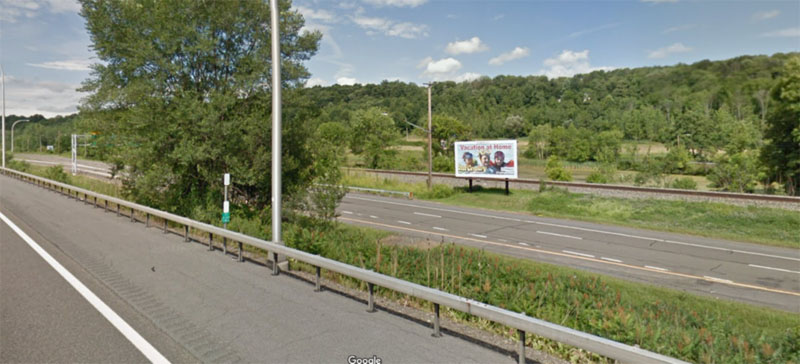
In Figure 2, we can see the billboard on the highway, located after the off-ramp from the interstate and before the on-ramp. People coming from the interstate are focusing on merging into traffic. Those wanting to take the on-ramp have to already be in the left lane, but are also jockeying with those coming off the off-ramp at high speed. Those continuing straight still have to contend with everyone else merging and exiting. A lot is happening here that is requiring significant concentration. Unless you're the only vehicle on the road, what are the chances of you checking out the billboard?
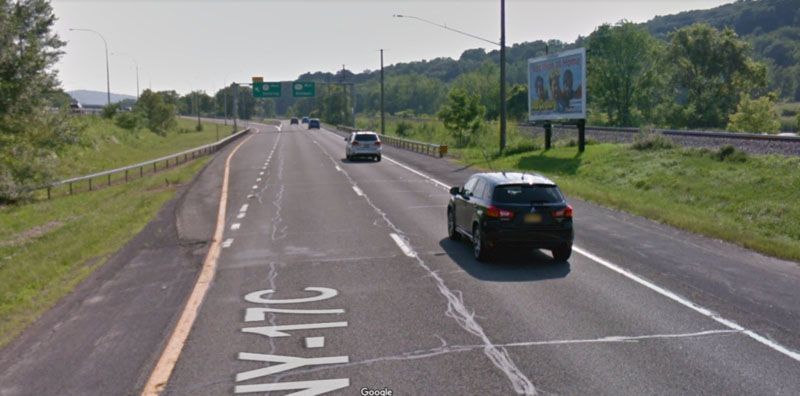
How about on the interstate itself? If you are in the right-hand lane, you should be fine, right? (Figure 3)
Well, this spot is just a few miles from a shopping mall. Imagine the car is full of young women, excitedly discussing their recent purchases and what they will wear to the dance clubs this weekend. The driver may be focused on the road, but the occupants undoubtedly have their attention on other matters.
Perhaps a driver's favorite, memories-retrieving song is playing on the radio.

What happens when a tractor-trailer going 10 miles per hour faster than the speed limit passes on your left? If you are driving a small car, the sudden change in the airflow may affect the handling of your car.
And see that spot in the median? That's known in our area where the police park with their radar detectors. Many of us keep a close watch on our speedometers when driving this stretch of the interstate.
Of course, the seasons can affect spotting that billboard as well. In the middle of summer it's .... well, I think it's behind those trees, where the arrow is pointing.
As you can see, businesses pay a lot of money under the promise that a certain number of people will "see" the ad they paid for. But there is no way to measure what those people are actually doing at that time, and what the priority is for their attention.
The same can be said when people start scrolling through their news feed. There is no guarantee that they are there to give their full attention to consuming content.
Why Was I Here?
On a slow day, yes, they could be carefully and slowly scrolling through the posts, looking for intriguing content to engage with, adding insightful comments to demonstrate their thought leadership.
Other times they may only have a few minutes to spend on the platform. They're going to be scrolling quickly, looking for some eye candy to entertain them. A thoughtful 1,270-character post about the latest industry trend might lose out to a Cheddar video.
Maybe someone got up on the wrong side of the bed that day. The first few words of a post, while completely innocent to most people, might set them off to either keep scrolling past or log off completely.
And a co-worker could distract them, and they lost track of where they were in the feed.
We don't live in a perfect world, and we have no control over the environment or the mindset people are in when they log into LinkedIn. Your post might have gotten massive engagement if you had posted it the day before or the day after. You never know. So in some ways, there is no reason to always beat yourself up if your posts are not getting the views that you think they deserve.
But still, I didn't feel that this was the complete answer to the problem. Why did some people report consistently low post view numbers, despite what they published or how they tried mixing things up? While others, who didn't have massive networks, managed to get significant engagement on a regular basis, no matter what they wrote or the day or time they published it?
Could there be yet another variable that no one mentions? After some analysis, I think I may have found it.
The Missing Link?
Before pivoting into B2B copywriting, my career was spent in engineering programming and corporate IT support. Being rather left-brained, I've often been able to spot the reasons why problems occurred, and can then obtain the data that confirms it.
In looking over my own LinkedIn numbers, I noticed a pattern. I suddenly realized that the reason for the low engagement of my content was staring right at me.
I was connecting to the wrong people!
No, I'm not talking about their job titles, or the industries they were in, or whether they were considered key people of influence. It wasn't about them as people, but rather their use of LinkedIn.
To confirm my theory, I went looking at the data LinkedIn has publicly released about its platform and its members.
At the time of this writing, using data and statistics available from January 2020, LinkedIn had 675 million users worldwide. From that base, 310 million were classified as monthly active users.
Think for a minute exactly what that last number means.
It says that only 46% of LinkedIn users log onto the platform at least once a month.
That means that 54% of all members go more than 30 days without even looking at their LinkedIn accounts!
Granted, those are worldwide numbers. But look at the graphical representation in Figure 4. Where do you think the majority of members of your network reside?
Are you sure?
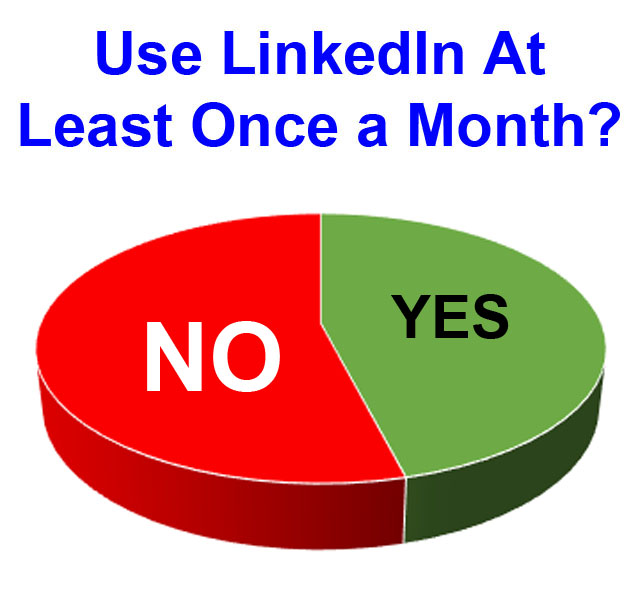
Remember How LinkedIn Posts Are Distributed
When you publish a post, the LinkedIn algorithm does not distribute it to everyone at once. It initially picks a subset of your network to put in their news feed. The type of engagement that your post gets, and how quickly, determines how many others in your network will start seeing it in their feeds.
But just like a throttle limiter on a car that sets the maximum speed that it can reach, there is a limiter on your post views too.
You are limited by the number of people in your network who are actually using LinkedIn on a regular basis — hopefully daily.
If a significant number of your connections rarely use LinkedIn, and of those that do, don't make reading and engaging with the content in their news feed a priority, then all of the work you do to make your content compelling runs into a brick wall.
Don't expect a few active connections, plus the people in their networks hopefully also being active, to give you the massive post view numbers you enviously see others report.
We're Connected, But I'm Still a Stranger
People accepting your connection invitations should also not be used as an indicator for future success, as I found out when I performed further analysis on data I had been collecting.
For my reference, I keep a simple text file of the connection invitations I send out. The information is grouped by what search criteria or source I used to find potential connections, and is listed by company name and individual's name. For each person, I note whether it was a basic invitation or a contact through InMail, whether or not they viewed my profile (now or anytime in the future), the date the invitation was sent and, if accepted, the acceptance date. This file also helps to prevent me from sending an invitation again in the future if a search brought up a person who did not accept a request from me in the past.
My first indication that I was perhaps not reaching out to the right people I had been observing for some time. As noted above, one of the checkpoints I tracked was whether or not they viewed my profile. I have Sales Navigator, which means not only can I see the names of all of the people who viewed my profile in the past 90 days, but also the total view count, along with the total count of those who viewed it in Private Mode. I track those numbers on a daily basis and, when I am actively sending out invitations, throughout the day as well.
What I was frequently seeing after getting the notification that someone had accepted my invitation was not only did they not appear among the names of those who viewed my profile, but neither the total view count nor the Private Mode count changed! They basically just blindly accepted my invitation!
How could that be? I can't believe that I'd written such an exciting, such a compelling, 300-character personalized message that they didn't even need to view my profile for them to make their decision. (I'm a good writer, but not that good.)
Wondering how bad it was, I've gone back through my file and analyzed the invitations I sent out from January 2018 until July 2020 — slightly over a two and a half year period. I found that only 24% of the people who accepted my invitations ever looked at my profile.
Those, of course, are the public views. Being generous and assuming that 5% operate in Private Mode only brings the number up to 29%.
That means that 71% of the people who accepted my connection invitation really had no idea who I was!
Does this sound like the kind of person who would be actively engaging in content on LinkedIn?
Of course, that also begs the question — how can this really occur?
Are They Accepting Connections From Somewhere Else?
Having always used LinkedIn solely on the desktop, I was obviously confused why someone would look at the notification to connect without clicking to view the profile first. Then I remembered another LinkedIn statistic.
As of February 2017, 57% of all LinkedIn users were using a mobile device. And no doubt that number is even higher today. Since people use those mobile devices for everything, including email, could that provide a clue?
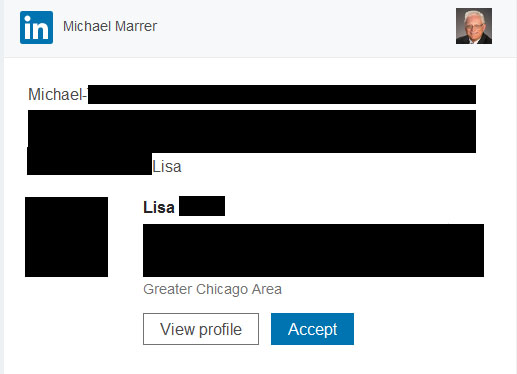
Because I respond to connection requests on the desktop, I never really paid any attention to the email notifications I received. I usually simply deleted them when I was in my email client. So I looked at the most recent one that I hadn't deleted yet.
The message, if personalized, is at the top. Then it shows the requester's profile picture, along with their headline. Perhaps, if the headline is sufficiently descriptive, that is enough for someone to make a decision — I don't know what criteria others use. Below that are two buttons, as shown in Figure 5.
Yes, there is a button to view the profile. But it doesn't really stand out, and blends in with the rest of the message.
But that big ol' blue button that says "Accept" — that's just begging to be clicked on to quickly complete the task. "One more email I can delete," they may be saying. "I'll check them out the next time I log into Linkedin." Which, of course, they forget to do.
Remember that 71% of my connections not only never viewed my profile at the time the invitation was sent and then accepted, but never ever looked at it at all anytime after that?
What Kind of Network Do YOU Have?
Perhaps at this point, you may be starting to understand that not all LinkedIn connections are created equal. Those people just quickly accepting invitations to get them out of the way, and those who collect connections like baseball cards (think LIONs, who connect with anyone who can fog a mirror), are probably not disposed to be sharing content and engaging with others. Or even logging into LinkedIn on a regular basis at all.
Take them out of the equation, and you've set a limit on how many views of your post are possible. You may have 2,000 connections, yet you only get 150 views for every post, and no likes or comments?
Are you starting to see the picture?
Let's do a little test that might give you an even better idea of the network you've built to date.
- Right-click on "My Network" to open it in a new tab.
- Click on "Connections".
- Your list will be presented in the order that you connected with them, with the most recent ones first. Scroll down about six months.
- Once you hit the six-month mark, start scrolling down and randomly pick a person. Don't pick someone you are familiar with and have been engaging with. You will probably see people you have forgotten about. Pick an unknown entity. (Hopefully, it will be someone with whom you initiated the connection invitation. If you are confident that they reached out to you, pick someone else, otherwise it may skew this test.)
- For that person, open their profile in a new tab (so that you do not have to rebuild this connection list).
- Open the "Activity" section of their profile. If one is not shown, you can display it by appending "detail/recent-activity" to their profile's URL.
- Start reviewing what they have been doing on LinkedIn. Do they post content, and if they do, how often? How often do they engage with other users' content, either through comments or simply liking a post? Are they liking only posts that their company or co-workers have made, and no one else?
- Now go back to your connection list, keep scrolling through these older connections, and do the above for another nine connections.
You may be surprised by the results of this exercise. Of those ten random people in your network, how active have they really been on LinkedIn?
What are the odds that they could have possibly seen your post?
If you see limited activity, could they be part of the 54% that goes more than a month without checking into LinkedIn?
The Secret Is Connecting With Better People
I've now implemented a new strategy in selecting the people I want to connect with. No longer is it simply based on their company, their industry and/or their skills, or how interesting the About section of their profile is. I'm taking the time to evaluate their activity. If they are not using LinkedIn other than to collect names like a Rolodex, then it isn't worth my time to try to connect with them. Even if they accept my invitation, they will not be part of the pool the LinkedIn algorithm uses when selecting who gets my content delivered to their news feeds.
And if you ever see what is shown in Figure 6, my advice to you is the very first word that The Doctor ever said to Rose Tyler:
"Run!"
(geeky Doctor Who reference)
Note: The above steps do not mean I will be completely disposing of anyone who does not meet this criterion — I'll be adding them to my flat file with a special notation. Just because they aren't activity using LinkedIn today does not mean that things might not change with them in the future. As such, I could be revisiting them six or twelve months down the road.
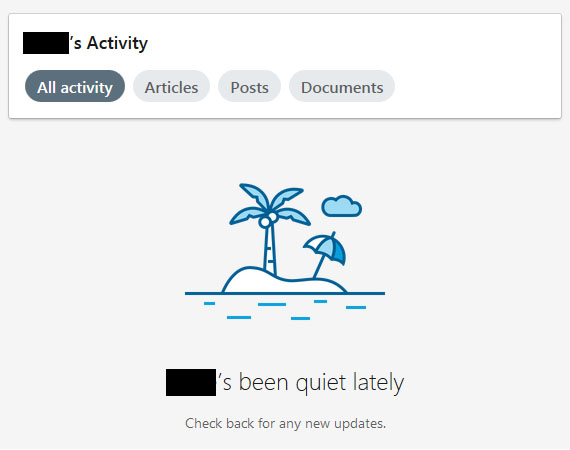
You Need To Change Your Goals
Your focus from now on should not be to simply find people to connect with.
Your focus should not be to simply create engaging content.
Your primary focus should be to find the people who, their own history shows, are not only active LinkedIn users, but also consistently post and engage with content outside their little immediate sphere (i.e., current company and co-workers).
Once you do that, you may be surprised to start slowly seeing an increase in your post views, and resulting likes and comments. You will no longer feel that you are shouting into a vacuum, and will begin having meaningful discussions with others.
The old saying of "past performance does not guarantee future results" is a great disclaimer in the field of investing. However, in regards to LinkedIn, I think examining past performance can stack the odds in your favor.
Conclusion
Finding people who have a track record of logging into LinkedIn on a regular basis and spending time on their news feed will help increase your post views. And having a majority of your network consisting of those who are disposed to liking and commenting on posts will increase your views even more, as those will be shown to their members in their network too (who hopefully have the same LinkedIn disciple that your connections do).
If your connections are not consistently doing anything on the platform, you need to find a new type of connections. Obviously, you won't see changes overnight, so give it time as you add your newly-qualified people.
© 2020 Michael Marrer, Silver Lake Wordsmiths & Marrer Enterprises, Inc.
Image © bowie15 | 123rf.com

